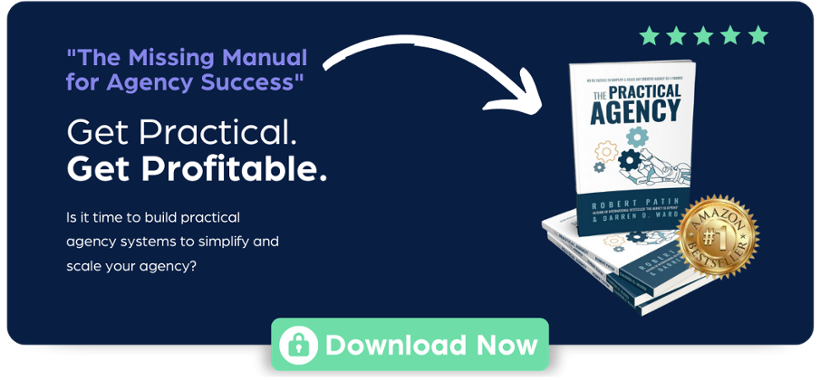Lead Generation for Marketing Agencies: Crafting a Winning Approach
Unlocking Agency Success: The Ultimate Guide to Profitable Offers
Navigating the maze of creative agency ownership comes with its fair share of challenges. Sometimes you're lying awake at night, fretting over razor-thin profit margins. Or perhaps you're at your desk, surrounded by forecasts and spreadsheets, yet accurate financial predictions seem as elusive as ever. And let's not forget the client relationships that start with promise but spiral into frustration and misalignment. These aren't just bumps in the road; they're glaring red flags signaling a deeper issue at the core of your business: your offer.
But these persistent problems you face aren't just random streaks of bad luck. They stem from something far more fundamental and, fortunately, within your control to change. Your offer—the very essence of what you're pitching to clients—might not be the irresistible proposition you think it is.
Luckily, this foundational flaw can be turned around. With a strategic overhaul, you can transform your offer into a powerhouse asset that not only alleviates these systemic issues but catapults your agency into a realm of profitability, predictability, and client relationships that are both rewarding and fruitful.
Unlocking Growth Through Specialization: The Power of Niching Down
The notion of narrowing your focus to a niche market often triggers a knee-jerk reaction of resistance among creative agency owners. The fear? That by choosing a niche, you're somehow shrinking your pool of potential clients and, by extension, capping your revenue potential.
However, this perspective stems from a scarcity-based mindset that overlooks the strategic benefits of specialization. Let's debunk this misconception and explore why niching down isn't a limitation but a catalyst for growth and efficiency.
Why Niching Down Works:
1. You become a specific solution to a specific problem:
Imagine needing heart surgery and having to choose between a general practitioner and a heart surgeon. The choice is obvious. Similarly, when clients are faced with a specific problem, they seek out specialists, not generalists. By niching down, you position your agency as the go-to expert for a particular set of challenges, making your offer significantly more attractive.
2. Operational Efficiency and Scalability:
Specializing in a niche allows your agency to streamline and perfect its processes for solving specific types of problems. This operational efficiency not only improves project turnaround times but also enhances your ability to deliver exceptional quality consistently. Over time, this efficiency translates into higher profit margins and scalability, as you're able to serve more clients with the same or even fewer resources.
3. Sharper, More Effective Sales and Marketing Messaging:
When you know exactly who you're talking to, crafting compelling sales and marketing messages becomes much easier. Your communications can address the unique challenges, desires, and language of your target niche, making every word resonate more deeply with potential clients. This specificity in messaging significantly improves the effectiveness of your marketing efforts, leading to higher conversion rates.
Identifying Your Ideal Niche:

So, how do you decide on the right niche for your agency? It starts with introspection and reflection on your personal story and professional journey. To help you narrow down the perfect niche for you, consider the following:
- What are you passionate about? Passion fuels perseverance, especially when the going gets tough. If you love what you do, it won't feel like work.
- Where do you excel? Look at your past projects and identify where you've made the most significant impact. What common threads exist in your most successful projects?
- Who do you enjoy working with? Think about your favorite clients or projects. What industries were they in? What problems were you solving?
- What unique perspective or experience do you bring? Your personal and professional background can offer unique insights or skills that set you apart in a specific market.
By considering these aspects, you can start to form a picture of who your ideal target market could be. Niching down is about aligning your agency's strengths and passions with a market segment that values and seeks out your specific expertise. It's a strategic choice that, far from limiting your potential, actually opens up a world of opportunity for growth, efficiency, and deeper client relationships.
Market Research: The Keystone of Your Offer
Understanding your dream clients’ needs, desires, and challenges is pivotal if you want to sculpt an offer that truly resonates. Market research isn't a mere formality; it's the bedrock upon which successful, client-centric offers are built. It's about diving deep, beyond the surface-level assumptions, to mine the gold of genuine client insights.
Here’s a detailed roadmap of what you should be paying attention to:
- Social Media Deep Dive: Platforms like LinkedIn and Twitter are treasure troves for insights. Don't just post polls; immerse yourself in the hashtags your target clients use. For example, if you're targeting tech startups, hashtags like #TechStartups, #Innovation, and #StartupChallenges can lead you to discussions that reveal what keeps your prospective clients up at night. Engage genuinely in these conversations to build rapport and gather firsthand insights.
- In-Depth Client Conversations: Beyond casual chats, schedule interviews with both potential and existing clients. Craft questions that dig into their experiences—ask about a recent challenge they faced with their branding or marketing efforts. For instance, "Can you walk me through a recent project where you felt your marketing strategy didn't deliver the expected impact? What do you think was missing?" These conversations can uncover specific pain points and the solutions clients are actively seeking.
- Exploring Forums and Customer Reviews: Venture into niche forums and review sites like Reddit's r/marketing or industry-specific LinkedIn groups. Look for threads discussing the struggles businesses face in your area of expertise. Similarly, analyze service reviews on platforms like Clutch.co to identify common themes in feedback. This research can spotlight gaps in the market that your agency is uniquely positioned to fill.
- Collaborating with Industry Insiders: Forge connections with professionals who cater to your target market from a different angle—be it digital marketers, web developers, or branding consultants, accountants, consultants, etc. Conduct joint discussions to exchange observations about client needs and industry trends. For example, a web developer might share insights about their frequent requests for more user-friendly website designs, which could inform your digital strategy services.
By diving into market research with a strategy focused on listening and learning, you position your agency to develop an offer that speaks directly to your ideal clients' deepest needs. This isn't about confirming what you already believe; it's about being open to surprises and ready to adapt your offer based on solid, actionable insights.
How To Craft A Winning Offer For Your Creative Agency
Now that you’ve gathered insightful feedback from your target audience, you need to present an offer that aligns with what your prospect is looking for.
Here’s a deeper dive into creating tiered service packages (and what common pitfalls to avoid):
1. Identify the Core Problem
Never make assumptions, and meet your target audience where they are currently at in their business. A common mistake is trying to address too broad of a problem, making your solution less impactful. Ensure the problem is specific enough that your solution can be seen as a direct and effective remedy.
For example: Your market research indicates that small e-commerce brands in your target niche struggle with converting social media traffic into sales, so you focus on promoting a conversion solution instead of content ideas or website design.
2. List Out Possible Solutions
Start with a brainstorming session focused on both your agency’s strengths and the specific needs of your target audience. Consider a mix of immediate solutions and long-term strategies.
Make sure you don’t overlook operational capacity. Ensure that the solutions you propose can be realistically executed by your team without overextending resources.
3. Creating Tiered Service Packages: "Good, Better, Best"
Humans love the perception of having a choice - and your agency’s prospects are no different. Take your new list of service offerings and organize them into three differently-priced package options to give your prospects the chance to pick what’s best for them:
For example, this could look like:
Package 1 - Good: A social media audit and basic optimization plan, offering a quick boost in engagement and traffic.
Package 2 - Better: The audit and optimization, plus content creation for a month, providing a more sustained increase in traffic and engagement.
Package 3 - Best: A comprehensive package including the audit, ongoing content creation, paid ad management, and conversion rate optimization strategies for a holistic approach to boosting sales through social media.
When you productize your agency’s service offering, not only does it make for an easier sales pitch, but you also will:
- Streamline Operations: Standardize as much as possible but allow for some customization within each tier to address specific client needs without complicating your processes.
- Encourage Value-Based Pricing: Clearly communicate the ROI of each package. For the "Best" package, illustrate how the investment is justified by the anticipated increase in sales.
- Improve Client Experience: Use clear, relatable examples to describe what each package includes and the kind of results the client can expect. This clarity helps manage expectations and builds trust.
Top 3 Creative Agency Offer Mistakes and How to Avoid Them
Even the best creative agency offer can fall flat if it is not supported by the right strategy. As you construct your new offer, make sure you are not:
- Underpricing Your Services: Don't let the fear of scaring away potential clients lead you to undervalue your services. Ensure your pricing reflects the value you deliver, especially in the "Better" and "Best" tiers.
- Failing to Adapt: The market and your clients’ needs will evolve. Regularly review and adjust your packages based on performance data and feedback to stay relevant and competitive.
- Neglecting the Customer Journey: Consider the journey a client takes from recognizing their problem to choosing your "Best" package. Each touchpoint should be designed to educate and nurture the lead further down the funnel.
By taking a structured approach to creating your offers and being mindful of these practical tips and pitfalls, you can design services that not only meet the specific needs of your target market but also position your agency for sustainable growth and success.
Advise, don’t pitch
So how do you transform your revitalized offer into cold, hard cash? The foundation of a successful sales conversation is listening. Aim to spend only 20% of the conversation talking, and let your prospect do the rest. This approach ensures that you gather as much information as possible about their needs, challenges, and goals:
Make sure you:
1. Ask the right questions.
To guide the conversation effectively, prepare a list of open-ended questions that encourage the prospect to share detailed information about their situation. Here are examples of questions that can unearth valuable insights:
- "Can you tell me about the biggest challenges you're currently facing in your business?"
- "How have you tried to address these issues so far, and what were the results?"
- "What does success look like for you in addressing these challenges?"
2. Craft a unique prescription based on your conversation insights.
Based on the insights gathered, formulate a "prescription" that outlines how your services can address their specific problems. Here's how to structure your recommendation:
- Summarize Their Challenges: Begin by summarizing the key challenges they’ve shared with you, demonstrating your understanding and empathy.
- "Based on our conversation, it sounds like your primary challenges are A, B, and C, which stem from issues X and Y."
- Present Your Solution: Next, introduce your solution as a natural next step to their problems, incorporating examples or case studies where you've successfully addressed similar issues.
- "To overcome these challenges, I recommend strategy D combined with approach E, similar to how we successfully helped another business in your industry."
- Offer Tiered Options: Present your tiered service options, allowing them to choose the solution that best fits their needs and budget.
- "We have a few ways we can tackle this: our Good option addresses A, our Better option includes A and B, and our Best package covers A, B, and C. Which of these aligns best with what you're looking for?"
- "We have a few ways we can tackle this: our Good option addresses A, our Better option includes A and B, and our Best package covers A, B, and C. Which of these aligns best with what you're looking for?"
3. Reinforcing the Prescription with Social Proof
Whenever possible, reinforce your prescription with social proof. Share testimonials, case studies, or examples of past successes that closely align with their situation. This not only builds credibility but also helps the prospect visualize the potential outcomes of working with you.
For example, present your social proof after the prospect shares their current business challenges with you:
"When we worked with [Similar Business], they were facing [Similar Problem]. By implementing [Your Solution], they saw [Specific Results]."
Launching Your Offer: The Essential Marketing Checklist
Creating a compelling offer is just the beginning. The way you introduce your offer to your target audience can significantly impact its success.
This detailed marketing checklist will guide you through the essential assets you need, ensuring each element is strategically designed and messaged for maximum impact:
-
Landing Page: Answering the Right Questions
- Design Focus: Ensure your landing page is not only visually appealing but also intuitive for users. Incorporate elements that reflect your brand's personality while guiding visitors smoothly toward the CTA.
- Messaging Strategy: Your landing page should answer these crucial questions: "What problem does this solve for me?" "Why should I choose this over others?" "What’s the next step?" Focus on presenting benefits that resonate emotionally and logically with your audience, using clear, compelling headlines and bullet points to highlight key advantages.
-
Email Campaign: The 20/40/40 Rule
- Welcome and Warm-up: Start with a welcome email that thanks new leads and briefly introduces what they can expect. Follow this with emails that focus 40% on providing value and building a relationship, and another 40% on warming up leads to your offer with soft sells and educational content.
- The Sales Push: Only 20% of your emails should be direct sales pitches. These should be well-timed, coming after you've provided enough value and information to make the pitch feel natural and expected.
- Design and Copywriting: Maintain visual cleanliness and readability, using engaging subject lines and personalization. Ensure consistency in tone across all emails, mirroring the language and style of your landing page.
-
Social Media Strategy: Beyond Posting
- Content Diversity: Craft a mix of content that educates, entertains, and sells. Videos, infographics, and thought leadership posts can help showcase your expertise and the value of your offer.
- Active Engagement: Dedicate time to interact with your audience and industry conversations, not just broadcasting your messages. Comment on posts, answer questions, and participate in discussions to build visibility and credibility.
- Targeted Advertising: Use paid ads to extend your offer's reach, carefully targeting based on your ideal client profile. Tailor ads to speak directly to their needs and interests, driving them to your landing page.
-
Sales Materials: Seamless Selling
- Pitch Deck Perfection: Your pitch deck should be a visually cohesive extension of your other marketing materials, focusing on the transformative benefits of your offer. Use data and success stories to back up your claims.
- Prep for Objections: Equip your sales team with scripts and FAQs that anticipate and address common objections, ensuring they can communicate your offer's value confidently and consistently.
By adhering to this checklist and focusing on strategic, benefit-oriented messaging and design, you position your offer not just as a choice, but as the solution to your dream clients' needs. Engaging actively on social media and following the 20/40/40 rule for emails will ensure your marketing efforts build the necessary momentum to turn interest into conversions.
Maximize Your Effort With Performance Metrics
To ensure your offer resonates effectively with your target audience and achieves your business goals, monitoring and analyzing performance data is crucial. This data not only provides insights into the effectiveness of your offer but also guides you in making informed adjustments to enhance its appeal and effectiveness.
Here’s how you can break down key metrics into actionable insights:
- Conversion Rate: Measures the percentage of prospects who take a desired action (e.g., signing up, making a purchase) divided by the total number of visitors.
- A low conversion rate often indicates that your offer isn't compelling enough, your sales pitch might be off, or the landing page is not effectively communicating the value.
- A high conversion rate (while generally positive) might suggest that you're not charging enough for your services, leaving money on the table.
- Lead Generation Volume: The total number of new leads generated in a specific period.
- Low Lead Generation: Suggests issues with your marketing efforts or that your offer isn't reaching or appealing to your target audience.
- High Lead Generation with Low Conversion: Indicates that while your marketing is effective in attracting interest, your offer or follow-up process may not be compelling enough to convert interest into action.
- Click-Through Rate (CTR) on Calls-to-Action (CTA): The percentage of clicks on your CTA compared to the number of times it's seen.
- Low CTR: Implies that your CTA is not effectively capturing attention or motivating action. This could be due to poor positioning, unclear messaging, or a mismatch with audience expectations
- Low CTR: Implies that your CTA is not effectively capturing attention or motivating action. This could be due to poor positioning, unclear messaging, or a mismatch with audience expectations
- Average Time on Page or Engagement Time: Tracks how long visitors spend on your offer's landing page or engaging with your sales content.
- Short Engagement Time: May indicate that your content is not engaging enough, or the offer doesn’t immediately resonate with visitors. It could signal the need for more compelling, relevant content or a clearer presentation of your offer’s value.
- Long Engagement Time Without Conversion: While it suggests that your content is engaging, it may also imply that visitors are confused or uncertain about taking the next step. Consider simplifying your offer or providing more direct calls to action to guide prospects towards conversion.
- Customer Feedback and Satisfaction Scores: Direct feedback from clients post-purchase or interaction scores (such as Net Promoter Score, NPS).
- Negative Feedback or Low Scores: Directly points to dissatisfaction with your offer or service delivery. This feedback is invaluable for identifying specific aspects of your offer that may require refinement or improvement.
- Positive Feedback with Low Referral Rates: If clients are happy but not referring others, it might indicate a lack of incentive or motivation to share their positive experience. Implementing a referral program or enhancing client benefits for referrals could stimulate growth through word-of-mouth.
By closely monitoring these metrics and translating them into actionable insights, you can continuously refine and improve your offer. This data-driven approach ensures that your offer remains compelling, competitive, and closely aligned with your target audience's needs and expectations, driving sustainable growth and success for your agency.
Transforming Theory into Triumph: A Case Study
Imagine an agency that, despite possessing the expertise to scale businesses at an astonishing pace, found itself mired in the quagmire of operational inefficiency and stagnant growth. This scenario mirrors many agency owners who, despite their hard work and dedication, struggle to break free from the cycle of project-based work and the relentless pursuit of new leads.
Embracing Specialization and Strategic Offers
The turning point for this agency came when it decided to redefine its target market, focusing sharply on specific industries that resonated with its expertise and aspirations. This strategic pivot was not just about narrowing their focus; it was about becoming indispensable to a select group of clients by addressing their unique challenges with unparalleled solutions.
Operational Overhaul and the Power of Productization
With a laser-focused target market, the agency could then productize its offer, crafting a service package that was irresistible to its ideal clients. This wasn't a mere change in packaging; it was a foundational shift in how they approached business. They transitioned from chasing project-based work to securing higher-paying clients on monthly recurring revenue deals—a move that redefined their operational model and financial trajectory.
The Results: A Testimony to Strategic Transformation
The outcome was nothing short of spectacular. By aligning its services with the needs of a well-defined market and offering productized solutions, the agency witnessed a 450% increase in revenue in just four months. This leap from a $5k loss to a $15k monthly profit epitomizes the essence of creating a killer offer. It demonstrates how well-articulated, market-researched, and strategically positioned offers can not only attract dream clients but also propel an agency to new heights of success and profitability.
This case study serves as a powerful reminder that the path to agency growth and financial freedom lies in understanding your audience deeply and crafting offers that resonate on a profound level. It reinforces the importance of moving away from generalized services to specialized, productized offers that speak directly to the needs of your target market. The agency's journey from operational stagnancy to explosive growth underscores the critical role of strategic planning, niche specialization, and the courage to break away from traditional business models.
Crafting a Killer Offer: Key Takeaways for Success
As we wrap up this comprehensive guide to creating a killer offer that resonates with your dream clients, it's crucial to reflect on the strategic steps that can transform your agency's approach to client acquisition and retention.
Here are the top four takeaways that every creative agency owner should keep in mind:
- Niche Down to Stand Out: Specializing in a specific niche allows you to become the go-to solution for particular challenges, enhancing your value proposition and making your offer irresistible to your target audience. It streamlines your operations and sharpens your marketing messaging, leading to higher efficiency and conversion rates.
- Market Research is Foundational: Understanding your target audience's deepest needs and challenges through thorough market research is non-negotiable. Utilize direct interviews, social media engagement, and collaborations with industry insiders to gather insights that inform your offer's development, ensuring it hits the mark.
- Productize Your Offer: Transitioning to a structured, tiered service model not only simplifies your sales process but also positions your agency for scalable growth. It enables value-based pricing and improves the client experience by providing clear, tailored options that meet their needs at various levels of engagement.
- Marketing and Sales Alignment: Your marketing materials, from landing pages to email campaigns and social media strategies, should all work cohesively to introduce and amplify your offer. Employing a benefit-oriented approach and maintaining active engagement with your audience are critical for turning interest into action.
Remember, the success of your offer (and, by extension, your agency) hinges on your ability to communicate its value effectively and to the right people. By following these strategic steps and keeping the focus on solving specific problems, you can ensure that your offer not only attracts attention but also delivers tangible results, paving the way for lasting growth and success.
Want to learn more about Lead Generation? Watch our video below on Evaluating Lead Generation Campaign.
Check out our Youtube Channel for more industry insights.










